 c180 ships 1947-today
c180 ships 1947-today
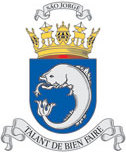 The Marinha do Portugal reflected in part the rule of Salazar for several decades, including its involvment in colonial wars. After the carnation revolution in 1974, the navy was completelty rebuilt and modernized under a new doctrine. The transition was made in the 1980s and 1990s and today presents a part of NATO which is quite unique and interesting in its capabilities and location, albeit modest.
The Marinha do Portugal reflected in part the rule of Salazar for several decades, including its involvment in colonial wars. After the carnation revolution in 1974, the navy was completelty rebuilt and modernized under a new doctrine. The transition was made in the 1980s and 1990s and today presents a part of NATO which is quite unique and interesting in its capabilities and location, albeit modest.
Portugal’s strategic position, and the fact that she eventually sided with the Allies during the Second World War, brought considerable benefits to her armed forces from the mid-1940s, in which the navy shared. Her fragile economy would not have supported a naval reequipment programme, but American aid started soon after the end of the war. In 1949, Portugal was a founder member of NATO and in 1951 she signed a treaty with the United States for establishing American bases in Portuguese territory, including the Azores. Warbuilt ships were transferred, but from the 1950s a modest programme of new building commenced.
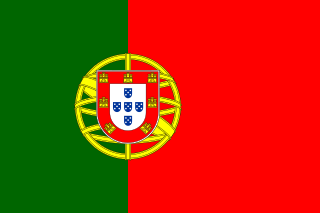 THE COLONIES: In the 1960s, Portugal still had an extensive overseas empire, and most of her warships, including a large number of small frigates and patrol vessels, were designed to patrol their waters. India invaded and annexed the colonies of Goa, Daman and Diu on the Indian subcontinent in December 1961, and the Portuguese Navy lost a frigate and two patrol boats in a futile effort to prevent this. In the face of widespread unrest in the African colonies where independence movements sprang up in Angola, Mozambique and Portuguese Guinea (now Guinea-Bissau), the navy was hurriedly expanded to assist the other services. Large numbers of simply equipped small frigates, patrol boats and landing craft were built in a few years.
THE COLONIES: In the 1960s, Portugal still had an extensive overseas empire, and most of her warships, including a large number of small frigates and patrol vessels, were designed to patrol their waters. India invaded and annexed the colonies of Goa, Daman and Diu on the Indian subcontinent in December 1961, and the Portuguese Navy lost a frigate and two patrol boats in a futile effort to prevent this. In the face of widespread unrest in the African colonies where independence movements sprang up in Angola, Mozambique and Portuguese Guinea (now Guinea-Bissau), the navy was hurriedly expanded to assist the other services. Large numbers of simply equipped small frigates, patrol boats and landing craft were built in a few years.
THE POST-COLONIAL ERA: The independence movements gradually won more and more territory. The end of Dr Salazar’s dictatorship appeared to change none of Portugal’s attitudes, but when his successor, Dr Caetano, was toppled by a military coup in April 1974, Portugal at last had leaders who were prepared to abandon the colonies and the drain they _ represented on the Portuguese economy and armed forces. The African colonies achieved their independence in 1974, 1975 and 1976, and most of the small craft built to serve in their waters were either transferred to Angola or Mozambique or scrapped.
PORTUGAL’S NAVY 1960s
A few medium-sized frigates were built in the 1960s to American and French designs, but the problems of the Portuguese economy have prevented any large-scale modernisation of these ageing ships and most of them are now suitable only for fishery protection duties. Many of the navy’s smaller vessels have been built in Portugal, but plans in the early 1980s to build new frigates locally were abandoned. Indeed, the acquisition of the three German-built MEKO 200 frigates in 1990 was possible only because a consortium of NATO countries provided 60 per cent of the funding.
In 1995, the Portuguese Navy had 15,000 personnel plus 2600 marines. In 1990 five Sea Lynx helicopters were ordered to form Portugal’s first seaborne aviation force. These are carried by the MEKO 200 frigates. Today, the Portuguese Navy counts 2 attack submarines,
Inheritance of WW2

Gunboard NRP Alfonso de Albuquerque, which stayed in service until her sinking on 18 December 1961 in Goa against the Indian Naval Forces
The Portuguese Navy was a small, ageing blue water navy in 1939 (Poster). The The Portugal Navy in WW2 took no paert and stayed neutral, enforcing neutrality. The subject of the Portuguese Navy in interesting, perhaps more than some Scandinavian neutral navies. Indeed, despite its neutrality, the Country that fathered Vasco Da Gama and so many legendary seamen and merchants, had once the largest colonial empire worlwide. And as the latter was a shadow of its former self in 1939, the Portuguese Navy still had potentially to defend it. Technically it was in the XXth century a “pluricontinental nation with overseas provinces”. These were Cape Verde, São Tomé and Príncipe, Guinea-Bissau, Angola, and Mozambique in Africa and in African seas, Macao and Goa in Indian waters. If the first were not really a concern, patrolled by rivering gunboats but too far away to constitute an interest for the axis, Macao and Goa interested Japan in 1942. While Goa was invaded, Macao became a de facto protectorate during the war. The island was attacked later by the USN.
Legacy DESTROYERS:
Douro class:
DIO 27.7.34 1,563t Discarded 29.11.60;
DOURO 16.8.35 1,563t; Discarded Dec 1959
LIMA 29.5.33 1,563t Discarded 16.10.65;
TEJO 4.5.35 1,563t; Discarded 9.2.65;
VOUGA 25.1.33 1,563t Discarded 3.6.67.
They were refitted during 1946-49 in Britain. The machinery was overhauled, the aft funnel shortened, the original funnel casings replaced by aluminium Ones to reduce top-weight, and a tripod foremast installed. The AA armament was increased to 340mm (3×1) and 3-20mm (3×1) and radar and sonar Was installed. They were again refitted in 1957 to enhance their ASW capabilities. Armament then consisted of 2—4.7in (120mm), 540mm (1×2, 3×1), 3-20mm, 1 Squid ASW mortar, 2 DC racks, 4-21in (533mm) TT.
Legacy SUBMARINES:
The Delfim class comprised DELFIM (launched 1.5.34) 1,092t, Discarded c1950; ESPARDARTE (30.5.34), discarded c1950; GOLGINHO (30.5.34) Discarded c1950. These three Vickers-built submarines were replaced by ex-British “S” class boats in 1948.
Legacy SLOOPS:
OU EONSO DE 28.5.34 2,440t Sunk 18.12.61; ALBUQUERQUE; BARTOLOMEU (10.10.34), Depot Ship DIAS Feb 1967, discarded c1969.
Velho class:
GONCALVES 28.11.32 1,414t Discarded c1969; ZARCO GONCALO VELHO (3.8.32) BU June 1961
Nunes class:
PEDRO NUNES 17.3.34 1,220t Discarded 1976; JOAO DE LISBOA (21.5.36) Discarded 17.8.66.
Albuquerque class:
These first-class sloops were re-rated as frigates. Albuquerque was sunk by the Indian cruiser Mysore and Indian destroyers during the Indian invasion and annexation of Goa in December 1961. Dias was converted to a depot ship in February 1967 and renamed Sao Cristovdo. All her armament except for ‘A’ and ‘Y’ position 4.7in (120mm) guns were removed.
Velho class:
Second-class sloops. These were reclassed as frigates, as were the second-class sloops of the Nunes class.
Nunes class:
Nunes was converted to a survey ship in 1956 and Lisboa in 1961. Her 20mm were replaced by 4-40mm guns (4 x 1).
Legacy GUNBOATS:
Zaire class:
DIO Oct 1929 397t Discarded c1970; ZAIRE (ex-Goa) 26.2.25 397t, Discarded c1960. Diu was used as a training ship from c1965.
Faro class:
FARO 1927 295t Discarded c1960; LAGOS 1930 295t Discarded c1960; TETE 1918 100t Discarded c1975
Azevia class:
AZEVIA 1941-42 270t Discarded 1975; BICUDA 1941-42 270t Discarded 1976; CORVINA 1941-42 270t Discarded 1975; DOURADA 1941-42 270t Discarded 1975; ESPILHA 1941-42 270t Discarded 1971; FATACA 1941-42 270t Wrecked 22.1.49.
Zaire class:
Faro class:
Faro and Lagos were employed as fishery protection vessels, Tete was a river gunboat on the River Zambesi. She was re-rated as a patrol boat in 1900,
Azevia class:
The Azevia class were all used as fishery protection vessels. Faraga became a total loss after grounding on 22 January 1949.
The Navy in the 1950-60s under Salazar
After World War II, Portugal was one of the founding nations of NATO, despite its regime, but this caracteristic was shared with its Neighbour, Spain under Franco. In the Cold War, the Portuguese fleet participated in the defense of the North Atlantic, dealing with the Soviet threat. Inside NATO it wa spushed towards proficiency in mine and ASW warfare. This was done in the context of colonial wars, in which the Navy took an important part.
The navy started with already existing ships that needed modernization and from the late 1940s many new vessels were transferred under MDAP: Nine frigates, three submarines, 14 patrol ships, 15 mine warfare ships. Naval Aviation was developed from 24 Curtiss SB2C Helldiver dive bombers which were used for many years as an ASW squadron. It was studied by NATO for other such initiatives. These were moved from Aveiro Naval Air Station to Montijo Naval Air Base.
In 1950, the Minister of National Defence and Chief of the General Staff were unified, which marked a common Navy-Army joint command.
There was however fierce opposition from naval aviators to in 1952, the Government placed the Naval Aviation under control of new newly automomous independent Portuguese Air Force. Its status thus became semi-autonomous. Naval Air Forces were fully integrated in 1958, and then disappeared by name and function, no longer a separate branch. Naval aviators and personnel either returned to the Portuguese Navy or joined the air force.
By 1962, the Portuguese fleet counted 16 ocean escorts (destroyers, frigates and avisos) as well as three submarines, 23 patrol vessels and 19 minelayers or all ranks. The Navy also had four survey vessels and a tanker as well as a buoy tender and a training ship.
From the late 1950s, however, the Portuguese Government started to account new external and internal threats in overseas territories and the naval forces were mobilized to carry and support the troops. On the other hand, commitment to European tasks needed a different type of navy and under NATO, an upgraded into modern anti-submarine weapons systems. So frigates, submarines and mine warfare vessels were needed in the North Atlantic. This came out off the new “Overseas” navy planned by the government. It was planned as a mobile intervention force with light aircraft carriers and assault vessels for a large Marine force. But budgetary speaking it went against NATO requirements for a fleet of specialized frigates and corvettes. There were accomodations to support small landing forces, but doubling as patrol ships. Guerrilla wars of the early 1960s needed also small vessels to operate on rivers and lakes in Portuguese Africa and argued for a third branch, a dedicated creation of brown-water navy counting many small patrol and landing craft.
This was accompanied by the ambition of a worldwide command, control and logistics capacity to adequately cover these Overseas territories. From 1957, Portuguese naval commands were created in Cape Verde (Angola), Mozambique and Goa (Indian Ocean) as well as in the Azores. Each had to manage its own area of operations, so the North Atlantic, South Atlantic and Indian Ocean. Each had its own local maritime defense commands and support facilities.
The Portuguese Navy also started to develop a global communications network with naval radio stations placed in all these Overseas territories. This this made the navy responsible for the long range inter-territorial radio communication and coordination with the Armed Forces.
Impact of the Colonial wars
The Portuguese Navy saw action in the cokd war at the occasion of two separate theaters, but both linked to its colonial history. After India was granted is independent postwar, the Indian Union soon vectored its attention on the lost colonial enclave in its territory, Goa. At the same time in Africa, in future Mozambique, Guinea and Angola, independence movements needed a large counter-insurrection operation.
Last stand in Portuguese India

At Goa, on the morning of 17 December 1961, the Indian Armed Forces attacked and invaded swiftly Goa, Daman and Diu. These three forces (land, air and naval) overwhelmed the local Portuguese forces. On the naval side only, the Indian Navy had an aircraft carrier plus two cruisers, eight frigates among others, against three small patrol boats, one in each of these enclaves. NRP Afonso de Albuquerque was based in Goa and barely seaworthy, she was used as coastal battery for Mormugao harbour and radio communications with Lisbon. Indeed the on-shore radio facilities were destroyed by the IAF in short order.
Afonso de Albuquerque fought the last naval gun engagement of the Portuguese Navy, at 12h00, 18 December against Indian frigates entering Mormugao harbour. Afonso de Albuquerque was ordered to sail out and engage these with its 120 mm guns. The duel lasted for an hour and after 400 rounds fire and many hits on two frigates, Afonso de Albuquerque herself suffered severe damage with 5 killed and 13 injured including the captain. Stranded, colors were struck and she was later evacuated by the crew, still under fire as no surrender sign was given.
The patrol boat NRP Vega in Diu on her side had no chance but face the Indian cruiser Delhi, with her only 20 mm gun. She maaged an Indian Vampire jet fighter however. But ue to this, the IAF then targeted her, until she was sunk,loosing two of her crew and captain killed, three injured.
War in Africa
The wars in Africa lasted for 14 years, 1961–1975 and had for consequence the carnation revolution, putting an end to the regime. The Portuguese Navy carried reinforcements, escorted transports, patroled and assaulted points in inland waters. The three territories in whic they operated were orders of magnitude larger than Portugal. These were Angola, Portuguese Guinea and Mozambique. In all three, amphibious missions of the Portuguese Marines multiplied, and the force was bolstered and ultimately divided between the Special Marines (fuzileiros especiais) and regular Marines (fuzileiros) mostly used to defend naval assets. The Portuguese Navy created for its strategy a brown navy as intended, made od countless small units, and that included both shallow draft patrol boats and landing craft, many designed and built in Portugal.
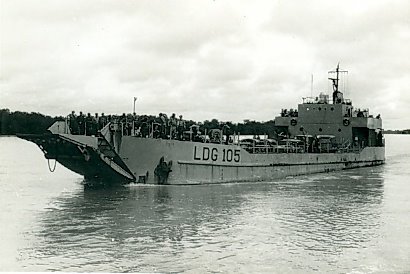
The landing craft NRP Bombarda preparing to land troops in Xime, eastern Portuguese Guinea, in 1969
Angola
The Navy wa sbusy patrolling and protectinf the mighty Zaire River, avoid border infiltration of UPA/FNLA and MPLA guerrillas, coming from Congo (later Zaire). Again, many patrol and landing crafts were gathered in the “Zaire Flotilla” but the river was deep enough to admit occasionally frigates. The buggets workload was done by modest rubber boats though. Patrolling the Zaire River was so successful that the Portuguese managed to completely stopped the infiltration of the guerrillas and defeat thse forces, retaking Northern Angola, and managing to winning the war in the early 1970s.
Independence movements re-orientated their activity to Eastern Angola, supprted by neighboring Zambia. The Navy adapted and started establishing naval and Marine units some 1,000 km (620 mi) from the sea coast on the Zambezi, Cuando, Cuanza rivers among others. The same methods that prevailed on the Zaire were used against the MPLA and UNITA guerrillas and by late 1968, base was created at Terras do Fim do Mundo, with the creation of an entire city from scrtatch, “Vila Nova da Armad”. From 1970, the Portuguese Navy in Angola always had a frigate (rotations) available, as well as four large patrol ships, 11 patrol motor launches, 15 landing crafts and two Special Marine detachments as well as four Marine companies, five detachments.
Guinea
The country characteristics allowed the Navy to give a higher contribution to the global effort. Thanks to a large array of navigable rivers and the rest being marshy, allowed the Portuguese Navy to control directly most of the territory and its hinterland regions. There, Portuguese forces fought a movement called the PAIGC which was probably the best trained and equipped and matched the Portuguese, in such a way it left guerilla and started to resemble a conventional war.
The PAIGC organized even its own Navy with Soviet/Warsaw Pact and Chinese vessels. It featured notably at some point P 6-class torpedo boats, and countless small boats, and had the support of the Senegal and the Republic of Guinea, offering sanctuaries for training and equipping new units constantly. This sometimes gave them the occasion to launch direct attacks against the Portuguese garrisons and then withdraw cross border. Teting to avoid diplomatic incidents, the Portuguese Navy could not do much. It focused on logistical supporting scattered military units and bring on demand fire support to land forces, amphibious forces and Marine units.

Author’s illustration of the Coutinho class
The Portuguese naval presence in Guinea which started in 1964 received additional landing craft and a Sapper Divers unit o deal with naval mines laid by PAIGC forces. In 1971 General Spínola created two more “African Special Marines” detachments, with personnel recruited locally. One operation they led against the PAIGC forces was against Como island and other near islands in the southern Portuguese Guinea by January 1964. Portuguese Armed Forces launched Operation Trident, which was a major conventional joint operation using a great deal of ship based helicopters completed with amphibious assaults on a wide area, with islands covered by naval bombardments and air strikes. The Frigate Nuno Tristão was used as central command post for coordination, and the bombardment was led by the destroyer Vouga. The assault consisted of seven patrol boats, eight landing craft, three Special Marines detachement and an Army battalion.
In 1970 was also launched the secret Operation Green Sea (Operação Mar Verde), a raid on Conakry in the Republic of Guinea to quell this PAIGC sanctuary. Under Lt.Cln Alpoim Calvão (task force TG 27–2), the patrol boats Cassiopeia, Dragão, Hidra and Orion, landing craft Bombarda and Montante deployed and covered some 250 Portuguese Commandos and Special Marines plus 150 political opponents of the Guinean dictatorship. The night of 21–22 November saw the city captured, the Guinean Army neutralized, and the local PAIGC assets captured and destroyed, also rescuing 26 Portuguese POWs. This was quite a stuning success, ambeit many of the PAICG insurgents escaped, the movements was severely crippled.
Mozambique front:
In Mozambique, the Portuguese Navy moslty operated from the large Lake Nyasa, to deal with FRELIMO infiltrations from Tanzania. In this, the Portuguese were helped by the Military of Malawi. The Nyasa Flotilla was created to operate from Metangula naval base and others, and again, with Portuguese marines. The base was needed for large scale logistical operations resting on 12 patrol and landing craft operating from the port of Nacala to Lake Nyasa over 750 km inland.
The Portuguese Navy transferred many assets the Nyassa Flotilla and organized the supply of Portuguese Forces operating in Northern Mozambique using the sea to main logistical centers located in Lourenço Marques and Beira. With the construction of the Cahora Bassa Dam the FRELIMO guerrillas started operations in the Tete region by the early 1970s and the Navy reassigned assets to the Zambezi River.
From 1966, the Portuguese Navy maintained also in the Mozambique Channel always a frigates on rotation, deterring possible British naval forces actions in the neighbouting port of Beira or establish an oil embargo of oil to Rhodesia after its declaration of independence.
From 1971, three frigates or corvettes were present almost permanently plus a logistical support ship and three patrol boats as well as one landing craft, all in the Indian Ocean and five patrol boats plus seven landing craft in Lake Nyassa and three Special Marines detachments, three Marine companies.
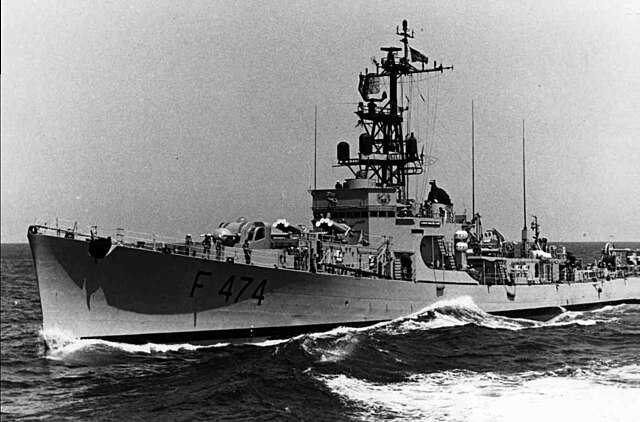
ASW Frigate NRP Almirante Magalhães Correia fulfilling in from its NATO missons in the North Atlantic
Other tasks needed commitment at long-range of the Navy to ensure logistics to Armed Forces stationed in Cape Verde and São Tomé and Príncipe, as well as the Portuguese Timor and Macau.
The focus was to acquire many small riverine units to deal with colonial wars, and that was detrimental to NATO commitment, despite the compromises found in the ship’s uses. Still, the Navy was pressed by NATO to commit at least four capable ASW patorllers and ocean escorts, and still usable for landing operations. This led to the adoption of avisos, those of the Comandante João Belo-class, ordered from French yards (Commandant Rivière class). Portuguese Navy engineer Rogério d’Oliveira meanwhile received an order for really tailored coervettes, which became the João Coutinho-class. They were trumpeted at the time (1969) as the first truly modular ships in the world with large internal spaces usable for rapid reconfiguration for ASW or amphibious operations, and while being still cheap to operate.
This was the base for many frigates and corvettes built later. For its African operations, the João Coutinho-class had a small draft for coastal or large rivers operations, with full accommodations for a force of Marines and their equipments. Six were built, followed by four Baptista de Andrade-class (1973), improved.
To fulfill its NATO missions in the North Atlantic the Navy built specifically three Almirante Pereira da Silva class anti-submarine frigates. Built at Lisnave, Lisbon ENVC in Viana do Castelo, they were essentually a copy of the US Dealey class escorts. In addition, the Navy acquired four Albacora-class submarines. This was accompanied by the installation of COMIBERLANT in Lisbon. The Almirante Pereira da Silva-class frigates became a permanent fixture of STANAVFORLANT as soon as it was created.
The 1974 Carnation revolution and consequences for the Navy
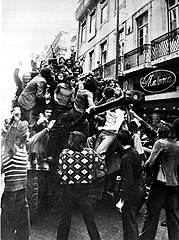 On the early hours of 25 April 1974, young officers of the Portuguese Armed Forces launched the Carnation Revolution, which by contagion (convincing other branches and units of the military) overthrewg the Salazar regime without bloodshed. STANAVFORTLAND left the Tagus the first day of the Revolution, with the frigate Almirante Gago Coutinho. The latter was ordered by the Portuguese Navy Staff to leave the international formation and returned to face the Terreiro do Paço riverside square, where revolutionary forces massed. The captain was ordered to open fire on rebel armored vehicles but the crew after some debate, refused. Long sorty short in a bout the day or so, the old Salazar regime, which ruled over Portual for more than fifty years was deposed, and a new democratic one was setup.
On the early hours of 25 April 1974, young officers of the Portuguese Armed Forces launched the Carnation Revolution, which by contagion (convincing other branches and units of the military) overthrewg the Salazar regime without bloodshed. STANAVFORTLAND left the Tagus the first day of the Revolution, with the frigate Almirante Gago Coutinho. The latter was ordered by the Portuguese Navy Staff to leave the international formation and returned to face the Terreiro do Paço riverside square, where revolutionary forces massed. The captain was ordered to open fire on rebel armored vehicles but the crew after some debate, refused. Long sorty short in a bout the day or so, the old Salazar regime, which ruled over Portual for more than fifty years was deposed, and a new democratic one was setup.

The Frigate Almirante Gago Coutinho was ordered to fire on the army and crowd gathered at the Terreiro do Paço riverside square, like this Panhard EBR ETT.
This new regime was notably motivated by the idea of putting an end to colonial insurrection and grant independence to the concerned territories. Motivation behind the revolution came mostly indeed from disgruntled officers in Africa, seeing the sum of death and destruction with little progress. Negotiated ceasefires in Angola, Mozambique and Guinea and repatriation of all troops and Marines with the fleet was decreted. In no time, the independence of the Portuguese African territories was decreted. The first was Guinea-Bissau and last Angola, on 11 November 1975. The plethoral of former small boats of the local brown navy commands were transferred to these new nations. Thousands of Portuguese troops and civilians were repatriated, covered and escorted by the Navy. Task force FO 15 (with the frigates Hermenegildo Capelo and Roberto Ivens, corvette General Pereira d’Eça, tanker São Gabriel and hospital-ship Gil Eannes, troop transport ships Niassa and Uige) also repatriated troops, being the last to leave the continent from the bay of Luanda, with Vice-Admiral Leonel Cardoso (last Portuguese governor) at its head.
Portuguese authorities also started preparations for the independence of East Timor (ex-Portuguese Timor), which saw no guerilla and everything was done “by the book” and legalized, but after dispute between new Timorese political parties dgenerated, Portuguese governor Mário Lemos Pires fled to Atauro Island, off Dili by late August 1975. The Portuguese Navy then picked him up with the corvette NRP Afonso Cerqueira by early October 1975 and later NRP João Roby. On 7 December 1975, Indonesia, freshly independent too (from the Netherlands) invaded East Timor.
Portuguese authorities evacuated the area with a small detachment sent to Australia to continue patrolling Timor waters for a possible counterattack. But i never happened as the new reguime left the situation as it was in 1976. International response to what happened in East Timor was weak to say the least.
By the end of 1975, Portugal was left without colonies and its Navy was now refocused on the North Atlantic only, and the Warsaw Pact. It was also reshaped to care about the redefined Portuguese EEZ which at the time was still the 10th largest in the world thanks to a few remaining overseas islands.
In 1976, the Portuguese fleet’s bedrock was constituted of the four Comandante João Belo-class frigates, three Almirante Pereira da Silva-class frigates, six João Coutinho-class corvettes, four Baptista de Andrade-class corvettes, three Albacora-class submarines, ten Cacine-class patrol ships, four support ships and one training ship, and the few small patrol boats and minesweepers or landing craft repatriated from Africa. The latter were ill-suited for Atlantic Operations, leading to plan a fleet retrofit program with anti-ship and SAM missiles on frigates and corvettes, with funds obtained by selling all the vessels that were not necessary. However the new regime was also strapped for cash, having to modernize the country and reinvest in all what was neglected by the previous regime. The Almirante Pereira da Silva-class frigatesr were never modernized and were considered obsolete, retired in the early 1980s, but placed in reserve at the Lisbon Naval Base until decommissioned in the early 1990s.
In the 1980s the Navy counted on four frigates, ten corvettes, three submarine, ten patrol ships and few minor units. The staff realized its lack of offshore patrol vessels, leaving the corvettes and frigates to patrol for fishery protection and maritime search and rescue, and being rapidly worn out as the result.
Post 1990
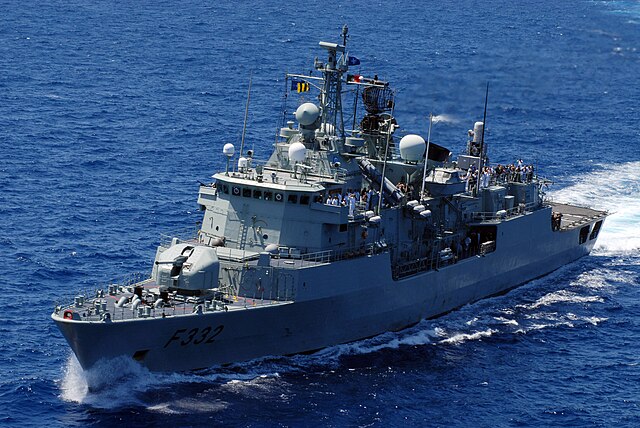
From 1990, the Portuguese Navy started to be a more visible, less shady instrument of foreign policy, withing the frame of NATO and the UN. The Navy operated as part of larger elements and coalitions and with the Portuguese Army and Air Force, for peace keeping and humanitarian missions, using for these ships, helicopter or sometimes the special force marine detachments. In hot zones, they helped evacuating Portuguese nationals and other foreign civilians, notably from Sub-Saharan Africa. The mission in Bolama (Guinea-Bissau, 1990) as a good example as well as in Luanda (Angola, 1992), and Bissau (Guinea-Bissau, 1998-1999). The language helped them communicating with the locals, and they were present in many combat areas. There were many instances of the Portuguese Marines Special Actions Detachment retrieving civilians to frigates off-shore.
The Portuguese Navy also took part in international peace-keeping operations, also with the European Union forces.
In the mid-1990s, an intense modernization effort commenced, starting with the MEKO 200 (Vasco da Gama-class) frigates and Argos-class patrol boats. The Naval aviation was reborn with these new helicopter-capable ships, around a core of Westland Lynx helicopters.
The Portuguese Navy took part in the liberation of Kuwait in 1990–91, dispatching the logistics ship NRP São Gabriel to support the coalition in the Persian Gulf.
The Balkan wars, revolving around the Adriatic, saw the Portuguese Navy ative with a Frigate maintainin the arms embargo under UN and NATO, and dispatching DAE special forces between 1991 and 2000 to monitor the shores and traffic. A Portuguese commander once headed NATO Operation Active Endeavour in the Mediterranean by December 2001 and January 2002.
The Portuguese Navy also contributed to joint EU exercises and helping Spain to prevent illegal immigration and drug-trafficking from and around the Canary Islands. The Prestige oil-spill incident on Northern Spain saw its neihgbour sending frigates and surveillance aircraft to providing independent monitoring of the area.
On 7 June 1998 the was a military coup in Guinea-Bissau so the Navy had to mount a major naval rescue operations to protect its citizens and evacuate them as a civil conflict hitting residents. The rescue operation was codenamed Operação Crocodilo. Most were rescued and repatriated on board the merchant ship MS Ponta de Sagres.
On 11 June Captain Hélder Costa Almeida commanded Ponta de Sagres into the Port of Bissau under artillery fire to rescue above 2,200 civilians including 500 Portuguese. Another naval force was sent under command of Captain Melo Gome. It comprised the frigate Vasco da Gama, corvettes Honório Barreto, João Coutinho, and the support ship Bérrio carrying Special Actions Detachment and the 22nd Marine Company and support elements in Guinea-Bissau on 15 June. The Port of Bissau was secured to help evacuation of citizens and foreign nationals, and later along the coast of Guinea-Bissau via rubber boats and helicopters.
On 28 June, a ceasefire was signed between belligerents on board the frigate NRP Vasco da Gama. The operation was over on 21 July 1998.
They took part in the UN mission in Kinshasa (Zaire, 1997) and Congo (1998) asw well as East Timor (1999–2004) and under the UE intervention in the Democratic Republic of Congo in 2006, NATO counter-piracy mission off Somalia, SAR after the flooding of the Save River in Mozambique (2000).
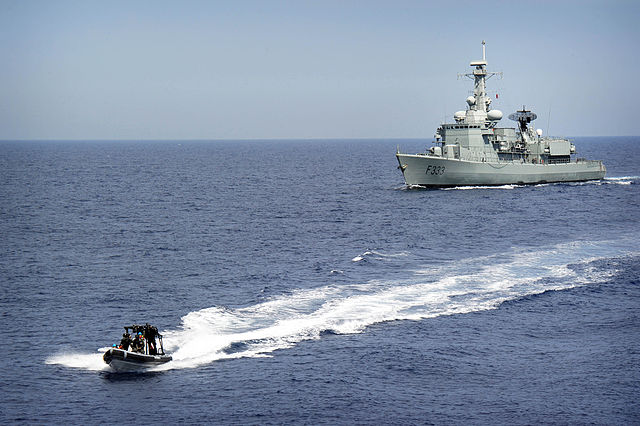
A VBSS team leaves NRP Bartolomeu Dias, lead frigate of the Bartolomeu Dias class
With the East Timor’s independence from Indonesia in 1999, Portugal sent two frigates and troops to protect the country from a possible new invasion. NRP Vasco da Gama and NRP Hermenegildo Capelo made a stay by mid-2001 as a company of 155 Marines as UN peacekeeping force. From 2004, Portuguese Marines were attached to the Timor Military Liaison Group and Portuguese National Republican Guard contingent in Dili.
The Bartolomeu Dias-class frigates bolstered the fleet which needed modernization, as the Tridente-class submarines, launched 2010 of the state of the art U 209PN type. Local yards such as the Estaleiros Navais de Viana do Castelo (ENVC) built the next generation of OPVs, freeing former frigates from EEZ enforcement and fisherly guard, with the Viana do Castelo-class patrol vessels replacing the João Coutinho-class and Baptista de Andrade-class.
The Vasco da Gama-class frigates Álvares Cabral and Corte Real were present in Indian Ocean and were used as NATO task-force flagships off Somalia. In 2009-2010, a NATO fleet was under Portuguese command in the Gulf of Aden, being awarded from “exceptional bravery at sea” by the International Maritime Organization to RP Corte Real when the piracy was at its peak.
Another role of the Portuguese navy was scientific, in oceanographic and hidrographic. The first under the Hydrographic Institute used proper Hydrographic Ships such as the Dom Carlos I-class research ships to determine the Extension of the Continental Shelf of Portugal, solidified by 2004. The shelf was extended by 200 nautical miles, a claim submitted to the UN by 2009, pending validation.
In the 2010s, the Immediate Reaction Force was sent to evacuated Portuguese citizens, with a mixed naval force on the ready, based from Cape Verde in 2012 to intervene in Guinea-Bissau if needed after a military. This force could be deployed withing 45h, with a frigate, a corvette, a Marine company and sappers divers, mine warfare detachment and other units if available.
The Portuguese Task Group (PO TG) is another permanent structure with acrtive ships for a national autonomous capacity, capable of power projection, and to include submarines, ocean escorts, amphibious and logistical support ships spec ops and even hydrographic assets, mission-based. It still waiting for the acquisition of a landing platform dock ship. The PO TG had been already well demonstrated at INSTREX exercises.
Organization
The main fleet
The Portuguese Navy depends on (CEMA, Chefe do Estado-Maior da Armada) with one full admiral in active service proposed by the government and approved by the President. The CEMA is also at the head of the National Maritime Authority before 2014.
The Naval Staff comprises all services of administration and management, naval component command wuth subordinate maritime zones commands (North, Center, South, Azores, Madeira), and Admiralty Council, a Superior Council of Discipline, a Medical Revision Board of the Navy, the Inspection-General of the Navy (inspecting ship’s state).
Bases:
Lisbon Naval Base: Support Unit, Central Facilities, Naval School, Hydrography and Oceanography School, Diving School, Naval Tech School, Integrated Training, Evaluation Center.
Service execution bodies: Hyperbaric, Naval medical centers, laboratories, Hydrographic Base, naval support.
Cultural and scientific departments, beside the Marine Academy.
Operational structure: Surface Ships, Subsurface, Helicopters Squadrons depending on the Marine Corps Command.
The Hydrographic Institute, Maritime Search and Rescue.
National Maritime Authority
The NAutoridade Marítima Nacional supervises the Portugese coast guard and its tasks: Security, safety, figh-guarding, life-guarding, Pollution care, but also lighthousesmanagement and maintenance. Until 2014, its tasks were performed by the Navy, with a dedicated branch. Constitutional issues due to internal security roles led to devise a new branch separated from the Navy, and separate organization. Both it and the Navy still override their own competences in some aspects. The analogue of the Navy Chief of Staff is the National Maritime Authority but in sub-échelon, maritime zone commanders also heads maritime departments corresponding to territorial jurisdictions managed by the AMN.
There is also “Admiral AMN”. The AMN structure includes a Directorate-General and a Maritime Police. Sub-departments are the Life Guard Institute, Directorate of Lighthouses, Maritime departments, Port authorities, Maritime delegations, Sea Pollution, and the AMN School.
This organization manages its own ships also since 2014 (list below) although at first they were loaned by the Navy.
The actual Portuguese Navy
Current ships:
 Bartolomeu Dias class Frigates (2006)
Bartolomeu Dias class Frigates (2006)
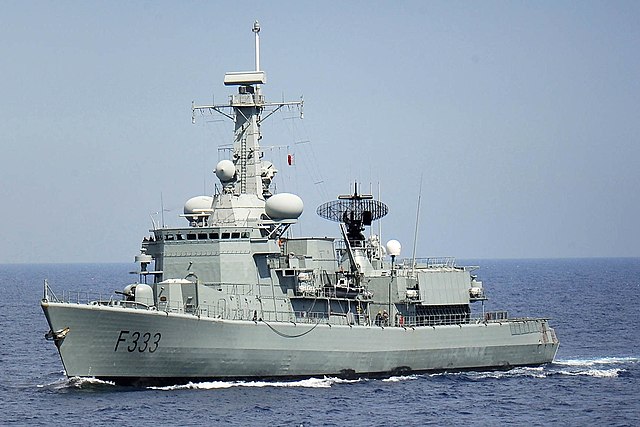
In the 2000s negociations led to the purchase of two-ex Karel Doorman class Frigates. In May 2006, indeed Portugal’s MoD under Luís Amado, showed interest in buying two Karel Doorman-class frigates and replaced two old João Belo class instead of two frigates Oliver Hazard Perry offered by the United States. A committee arrived in the Netherlands to evaluate the condition of two existing frigates to be bought. On 1 November 2006 MoD Nuno Severiano Teixeira signed a contract for the purchase of Van Nes and Van Galen. The first was transferred on 16 January 2009 and the second on 15 January 2010.
Class:
Bartolomeu Dias (F333), commissioned 2009, active service.
Dom Francisco de Almeida (F334) commissioned January 2010
Before these, They were already planned for acquisition as completed, of three frigates of the previous Kortenaer class already expected in 1982. Modified to Portuguese requirements. It was funded by a consortium inside NATO, the first planned to be built in the Netherlands and the two others in Portugal. But all was cancelled in August 1984. It was decided soon after to purchased MEKO 200 type Frigates to Germany instead.
These frigates are today in reinforcement of the three MEKO 200, NRP Vasco da Gama (F330) (In overhaul 2024), NRP Álvares Cabral (F331) and NRP Corte-Real (F332).
Only two older corvettes remained:
-1971 NRP António Enes (F471) of the João Coutinho class
-1975 NRP João Roby (F487) of the Baptista de Andrade class.
 Portuguese OPVs
Portuguese OPVs
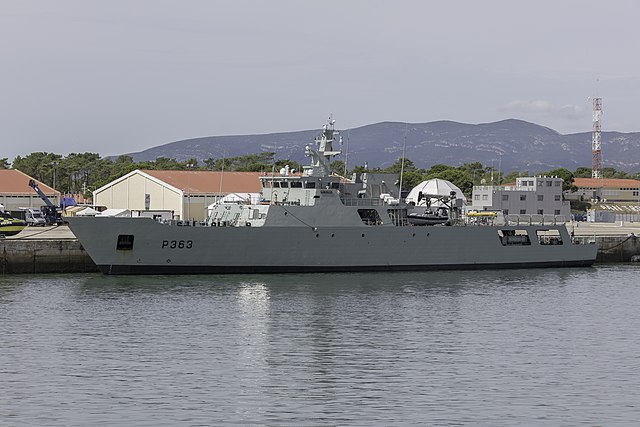
Viana do Castelo class (2010):
NRP Viana do Castelo (P360), NRP Figueira da Foz (P361), NRP Sines (P362), NRP Setúbal (P363), 6 more ordered in 2023.
Portuguese built, at Estaleiros Navais de Viana do Castelo (ENVC) and West Sea Shipyard.
Tejo class (1992):
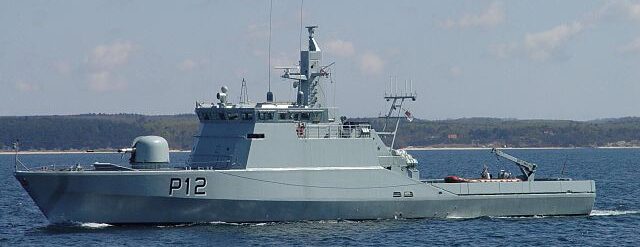
NRP Tejo (P590), NRP Douro (P591), NRP Mondego (P592), NRP Guadiana (P593). Danish Flyvefisken class vessels sold to Portugal in 2014.
Displacement: 320 t, Length: 54 m, Speed: 30 kn, Range: 3860 NM, Complement: 19.
Argos class (1991):
Patrol boats built at the Estaleiros Navais de Vila Real de Santo António.
NRP Argos (P1150), NRP Dragão (P1151), NRP Escorpião (P1152), NRP Cassiopeia (P1153), NRP Hidra (P1154)
hhhhhhhhhhhhhh
Portuguese Naval Aviation
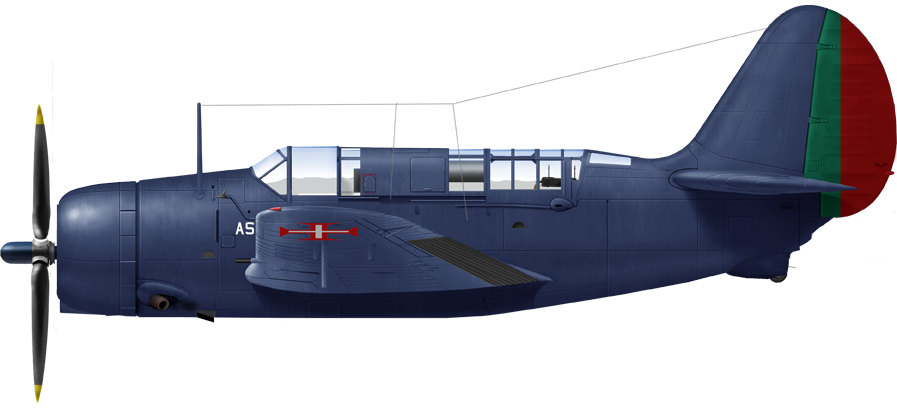
The last major acquisition of this old corps, created in 1917, was in 1950, with the acquisition of surplus Curtiss SB2C Helldiver dive bombers through the MDAP (Mutual Defense Assistance Act). They were a dedicated anti-submarine squadron based at São Jacinto in Aveiro. These 12 Helldivers of the Aviação Naval Portuguesa were operated until the late 1950s. In 1951, the Naval Aviation tested at the Lisbon Naval Aviation Centre, a civilian Westland WS-51 Dragonfly Mk.1A helicopter to develop shipborne operations. It was was later sold to Italy and the Italian Air Force. After the unification of the Army and Navy services under the Subsecretariado de Estado da Aeronáutica, the Força Aérea Portuguesa (FAP)) created in 1952 integrated all former Naval Aviation assets, but they still formed a semi-independent branch for operations and training under the name Forças Aeronavais. By 1958 it was disbanded with technicians and officers returning to the Navy.
Until 1993, the Portuguese Air Force performed the tasks of Naval Aviation. These assets were based at Montijo Naval Air Station.
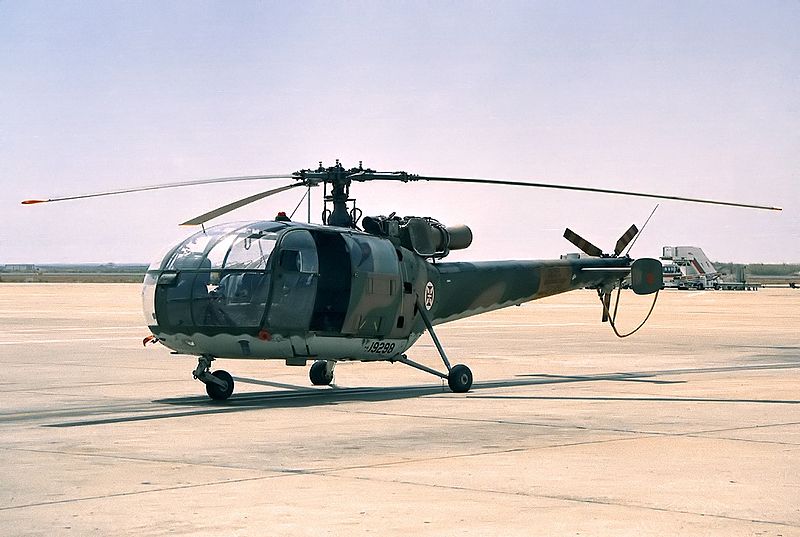
In 1964, the Guinean War saw a FAP Alouette II helicopter operated from a Portuguese Navy ship, for personnel transport and medical evacuation. The frigate Nuno Tristão for this had a makeshift wooden helipad built. Another was soon also based on the support ship Sam Brás.
Postwar, there were Alouette III operating from the deck of João Coutinho-class and Baptista de Andrade-class corvettes and support ship São Gabriel. In 1987, the modernization of the João Belo-class frigatespushed for a proper flight deck with telescopic hangar, until cancelled.

A Portuguese Navy Lynx prepares to land aboard the frigate Bartolomeu Dias
A Portuguese Navy Lynx helicopter takes off from the flight deck of the frigate NRP Vasco da Gama
The Navy’s Helicopter Squadron (Portuguese: Esquadrilha de Helicópteros da Marinha, EHM) was created when the new MEKO 200 Vasco da Gama-class frigates were acquired from Grmany, as they included a built-in hangar and helipad. These helicopters were used for anti-submarine warfare.
 Diego Gomes class Frigates (River)
Diego Gomes class Frigates (River)
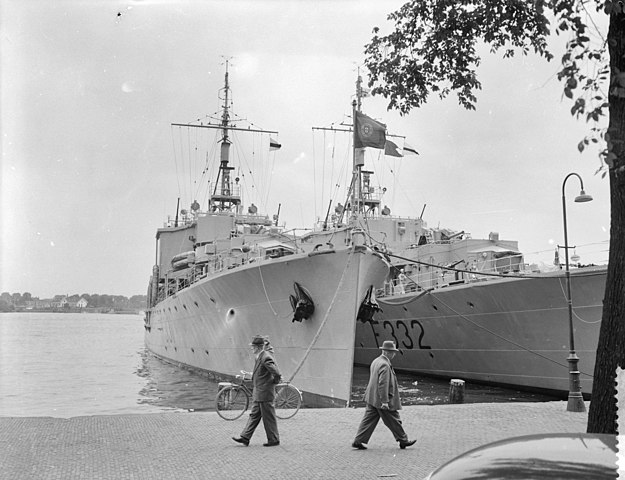
These two ex-British ‘River’ class frigates, launched in 1943, were purchased by Portugal in 1948 and transferred in May 1949. Both were refitted in 1959 when their ASW armament was modernised. The Hedgehog ASW mortar on the forecastle was removed and the 4in (102mm) gun moved farther for ward. Two Squid ASW mortars (2 x 3) were then positioned side by side between the gun and the bridge.
Ex-British ‘RIVER’ class frigates Particulars: As British ‘River’ class F331 DIOGO GOMES (ex-Arve), NUNO ‘TRISTAO (ex-Avon) Acquired May 1949, previously Built at lileming & Ferguson
F 332 Charles Till May 1949. DCT were also removed, The armament then consisted of 2-4in (2 x 1), 640mm, 2 Squid ASW, 2 DC racks.
 Diego Cao class Frigates (WGT DDEs) (1957)
Diego Cao class Frigates (WGT DDEs) (1957)
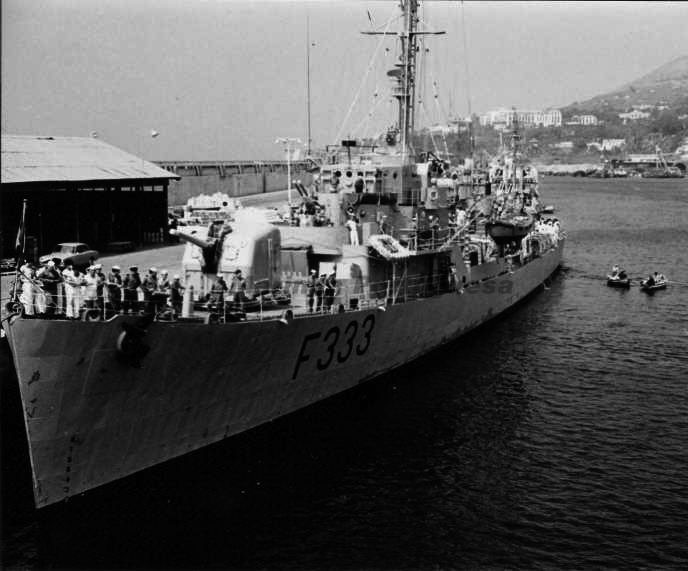
Formoe was originally to have been renamed Zaire and Revnolds, Zambese, but when the two ex-USN ‘WGT type DE (launched 1944) were transferred under MDAP on 7 February 1957 they were actually renamed Cao and Real respectively.
Both had their 3x 21-in (533mm) TT removed, leaving an armament of 2x 5-in/38, 10-40mm AA (1 x 4, 3 x 1), 1x Hedgehog, 8 DCT, 2 DC racks. They were rated as frigates by the Portuguese.
The class comprised the ex-US JOHN C BUTLER class destroyer escorts (WGT type): F 333 DIOGO CAO (ex-Formoe), F 334 CORTE REAL (ex-McCoy Reynolds)
Builder: Federal Federal, Acquired 7.2.57 and 7.2.57.
 Cabral class Frigates (Bay class)
Cabral class Frigates (Bay class)

Ex-British ‘Bay’ class AA frigates, launched in 1944-45. Cabral and Pereira were purchased in April 1959 and transferred to Portugal on 11 May 1959, and De Almeida and Da Gama were purchased in May 1961 and transferred after a refit on 3 August 1961. A half-sister, Alfonso de Albuquerque, ex-Dalrymple, ex-Luce Bay, built by Wm Pickersgill, launched 12 April 1945 and completed in 1949 as an unarmed survey ship, was purchased by Portugal in April 1966. She was employed as a survey ship and was stricken in 1983.
Ex-British ‘BAY’ class frigates: F 336 As British ‘Bay’ class Builder Hill Acquired Apr 1959. ALVARES CABRAL (ex-Burghead Bay) D FRANCISCO DE ALMEIDA (ex-Morecambe Bay) VASCO DA GAMA (ex-Mounts Bay) PACHECO PEREIRA (ex-Bigbury Bay), F479 Pickersgill May 1961, F 478 Pickersgill May 1961, Hall Russell F 337 Apr 1959. F 474 Viana do 4.11. Castelo 30,8.63 26.4.65. Proposed modernisation programme was abandoned and they were all deleted c1989.
 Frigate PÊRO ESCOBAR (1957)
Frigate PÊRO ESCOBAR (1957)
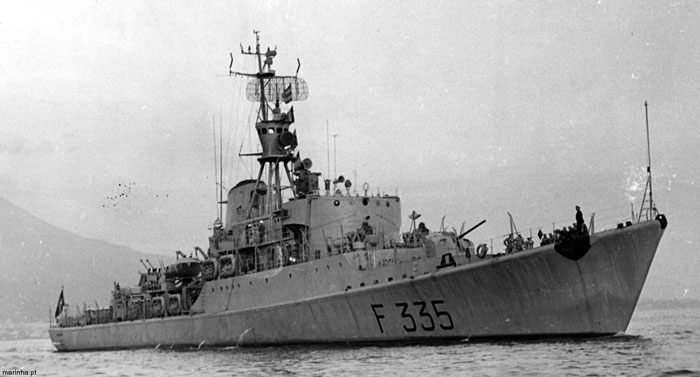
Pero Escobar had the same basic hull and machinery as the Italian-designed Venezuelan Almirante Clemente class, but had a considerably lighter armament to reduce topweight. She was modernised in 1968-69 to improve her AA and ASW armament, and was rearmed with 4-3in (76mm) (2 x 2), 2 Squid ASW mortars (2 x 3) and 6-12.7m (324mm) TT (2 x 3). She had MLT-3A and MLA-1B radar and SQS-29 sonar fitted, and this armament made her equivalent to the Da Silva class frigates. Pero Escobar was built to a NATO order.
Specs: Displacement 1,250t standard; 1,600ft full load, 321ft 6in oa, 306ft 9in wl x 35ft 6in x 10ft, 98.0, 93.5m x 10.9m x 3.1m
2-shaft geared steam turbines, 2 boilers, 24,500shp = 32kts. Range 2800n 2-76mnv/50 DP (2 x 1), 240mm (1 x 2), 3-533mm (21-in) TT (1 x 3), Crew 165
Builder: Castellammare. Laid down 7.1.55, Launched 25.9.55, Comp. July 19. as F 335.
 Alm. Pereira da Silva-class frigates (Dealey, 1963)
Alm. Pereira da Silva-class frigates (Dealey, 1963)
ALMIRANTE PEREIRA DA SILVA, ALMIRANTE GAGO COUTINHO, ALMIRANTE MAGALHAES CORREA.

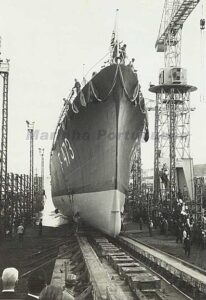 These three ships were built in Portual to a slightly modified version of the US Dealey class DE design. The ships were fitted for prolonged service in tropical waters and they had 214.75in (375mm) Bofors ASW rocket launchers (2 x 4) in ‘B’ position in place of Weapon Alfa, plus 612.75in (324mm) Mk 32 ASW TT (2 x 3). The complement was 166 and they were fitted with MLA-1B search, Type 978 tactical, SPG-34 fire control and RM-316P navigational radars and SQS-30 (Da Silva), SQS-31 (Coutinho), SQS-32 (Correa) search, SQA-10A VDS_ and DUBA-3A attack sonar. They were built in Portugal under MDAP. Almirante Pereira (US DEALEY type) frigates were otherwise similar to the US Dealey class.
These three ships were built in Portual to a slightly modified version of the US Dealey class DE design. The ships were fitted for prolonged service in tropical waters and they had 214.75in (375mm) Bofors ASW rocket launchers (2 x 4) in ‘B’ position in place of Weapon Alfa, plus 612.75in (324mm) Mk 32 ASW TT (2 x 3). The complement was 166 and they were fitted with MLA-1B search, Type 978 tactical, SPG-34 fire control and RM-316P navigational radars and SQS-30 (Da Silva), SQS-31 (Coutinho), SQS-32 (Correa) search, SQA-10A VDS_ and DUBA-3A attack sonar. They were built in Portugal under MDAP. Almirante Pereira (US DEALEY type) frigates were otherwise similar to the US Dealey class.
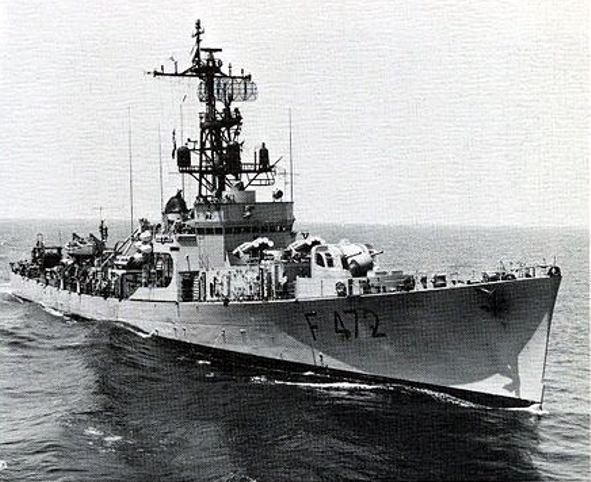
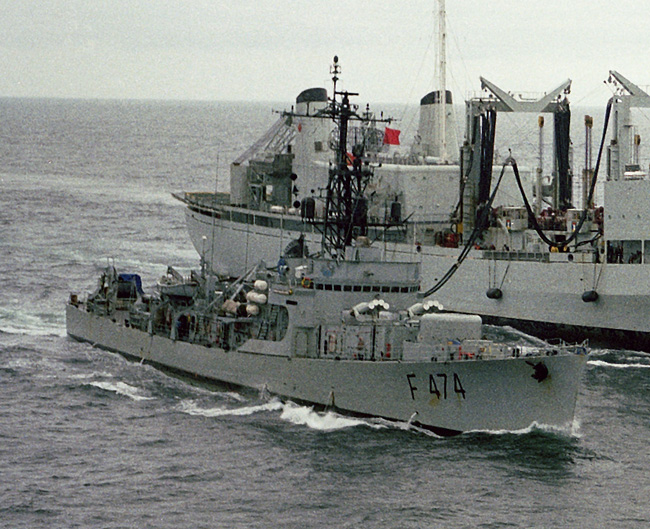

⚙ Almirante class specifications |
|
| Displacement | 1,914 t (1,884 long tons) |
| Dimensions | 95.9 x 11.18 x 5.33m (314 ft 8 in x 36 ft 8 in x 17 ft 6 in) |
| Propulsion | 1 shaft De Laval geared turbine, 2× Foster-Wheeler boilers 15,000 kW (20,000 shp) |
| Speed | 27 knots (50 km/h; 31 mph) |
| Range | 3,220 nmi (5,960 km; 3,710 mi) at 15 knots (28 km/h; 17 mph) |
| Armament | 2× 3 in, 2×3 21 in TTs, 2× 14.75 in ASWRL, 2× DCT |
| Sensors | Mark 63 fire-control system |
| Crew | 166 |
 Belo class Frigates (1966)
Belo class Frigates (1966)
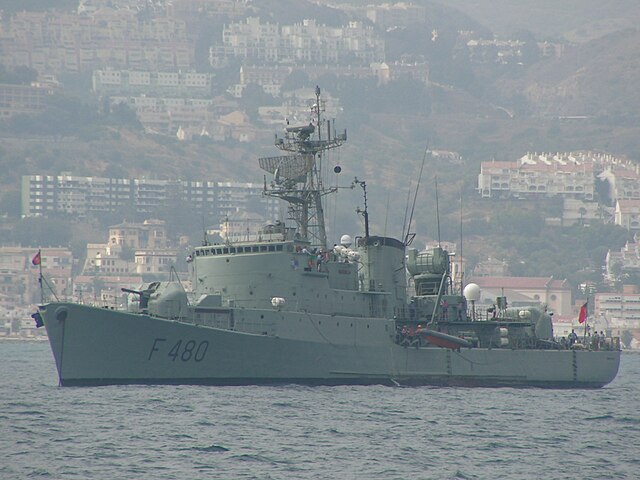
The Belo class are very similar to the French Cdt. Rivière, but are fitted for tropical service and have 2x 40mm/70 in place of the Riviere’s 2x 30mm (2 x 1). The Belos have a complement of 200 and have DRBV-22A search, DRBV-50 tactical, DRBC-31D fire control and RM-316 navigational radars, with SQS-17A search and DUBA-3A attack sonars. In the mid-1980s it was planned for this class to undergo a major refit, with one or both of the after 100mm turrets to be replaced with a helicopter deck and hangar on two ships, and with SSM on the other two, but this was abandoned due to cost. Instead, their ASW capability is to be modernised, in a programme due to complete at the end of 1995.
The Joao Coutinho class were designed by Blohm and Voss, Hamburg and built by them and by Bazan, Spain. They were relatively cheap and sparsely equipped light frigates, which could be acquired by Portugal in sufficient numbers to replace the old second-class sloops, corvettes, and gunboats. They can carry thirty-four marines, and their chief function until 1975 was patrolling off Portugal’s colonies.
There is provision for a light helicopter to land aft. As with the Belo class, a proposed modernisation including the fitting of SSM and SAM was cancelled for financial reasons. All ASW armament and sonar had been removed from the ships of this class by 1987, and the obsolete MLA-1B air-search radars had been replaced by a Kelvin-Hughes surface search set, more suited to their current role as fishery protection vessels. The De Andrada class utilised the same hull and machinery as the 7 Coutinhos, but had a more sophisticated armament and sensors. They have a helicopter platform but no hangar. After the withdrawal from the colonies, all four were to be sold to Colombia in 1977, but the deal was not completed. Lack of funds has prevented any modernisation plans for this class, and Baptiste de Andrada was placed in reserve in 1991, and Alfonso Cerqueira was stricken in 1994, Neither of these two classes is particularly well armed or equipped and are only really usable for coastal patrol or fishery protection duties.
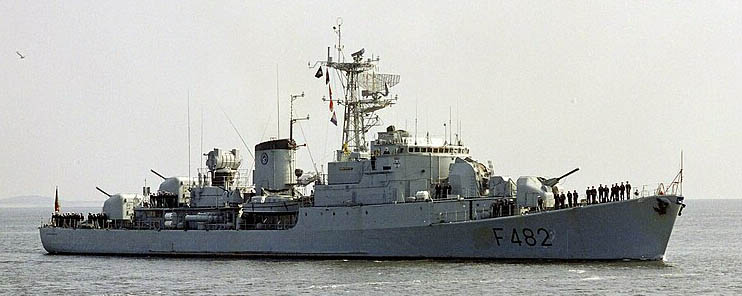
Commandante Roberto Ivens (F482)
⚙ Joao Belo class specifications |
|
| Displacement | 1,780 t (1,750 long tons), 2,290 t (2,250 long tons) full load |
| Dimensions | 102.7 x 11.7 x 4.4m (336 ft 11 in x 38 ft 5 in x 14 ft 5 in) |
| Propulsion | 2 shafts, 4 diesels SEMT Pielstick V12 PC 16,000 bhp (12,000 kW) |
| Speed | 26.6 knots (49.3 km/h; 30.6 mph) max |
| Range | 4,500 nmi (8,300 km; 5,200 mi) at 15 kn (28 km/h; 17 mph) |
| Armament | 3× 100 mm (3.9 in), 2× 40 mm (1.6 in), 1× 305 mm (12 in) ASWRL 2×3 550 mm (22 in) TTs |
| Protection | ARBR10 radar detector |
| Sensors | DRBV22A S.radar, DRBC31D FC radar, DRBV50 S.search, DUBA3 sonar, SQS17 sonar |
| Crew | 217 |
 Coutinho class Frigates (1969)
Coutinho class Frigates (1969)
António Enes, João Coutinho, Jacinto Cândido, General Pereira D’Eça, Augusto de Castilho, Honório Barreto
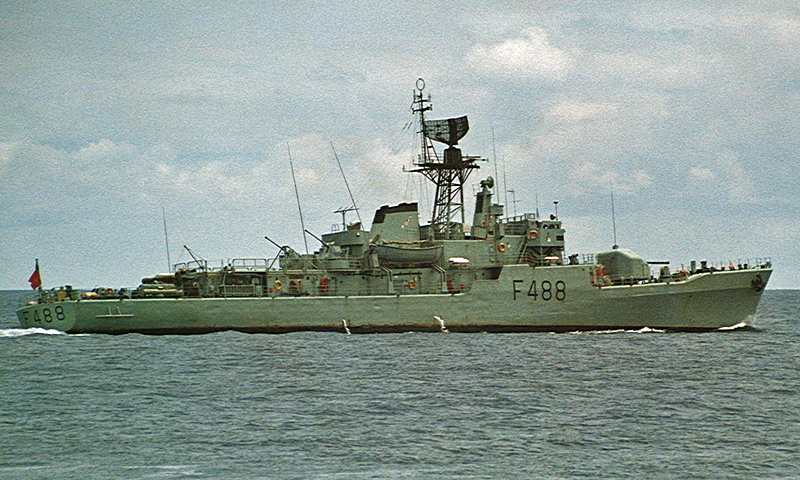
The history of Portuguese plans for new frigates has been somewhat complicated. In 1982 it was expected that three frigates bascd on the Netherlands Kortenaer class and modified to suit Portuguese requirements would be built in a programme Vasco da Gama as completed On 25 July 1986 three MEKO 200 type fmgates were ordered from Blohm & Voss, Hamburg (one) and Howaldtswerke, Kiel (two). These were the ships finally chosen by the Portuguese Navy, after considering the Netherlands Kortenaer type (see above) and a Spanish proposal. The programme was 60 per cent funded by a NATO consortium comprising the USA, Canada, West Germany, Norway and the Netherlands. Similar ships have been built for Greece and Turkey.
These ships give the Portuguese Navy its first seaborne aviation capability, each carrying one Sea Lynx helicopter.
Status: F471 NRP António Enes in active service, the rest decommissioned 2011-2018. 2 scrapped, 2 waiting for, 1 sunk as reef.
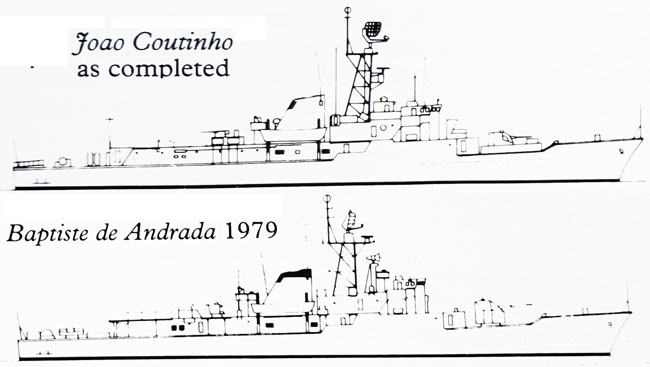
⚙ specifications |
|
| Displacement | 1,252 t (1,232 long tons) standard, 1,401 t (1,379 long tons) full load |
| Dimensions | 84.6 m (277 ft 7 in) x 10.3 x 3.3 m (33 ft 10 in x 10 ft 10 in) |
| Propulsion | 2 shaft, 2 OEW Pielstick diesel engines, 7,870 kW (10,560 bhp) |
| Speed | 24.4 knots (45.2 km/h; 28.1 mph) |
| Range | 5,000 nmi (9,300 km; 5,800 mi) at 18 knots (33 km/h; 21 mph) |
| Armament | 1×2 3 in/50 Mk 33, 1×2 40 mm/L70 Bofors, Hedgehog, 2× DCT, 2× DCR (removed 1987) |
| Sensors | WE AN/SPG-34 FC radar, Kelvin Hugues SS radar, MLA-1B AS radar, QCU-2 sonar |
| Crew | 93+ 34 Marines |
 Baptista de Andrada class Frigates (1972)
Baptista de Andrada class Frigates (1972)
Baptista de Andrade, João Roby, Afonso Cerqueira, Oliveira e Carmo
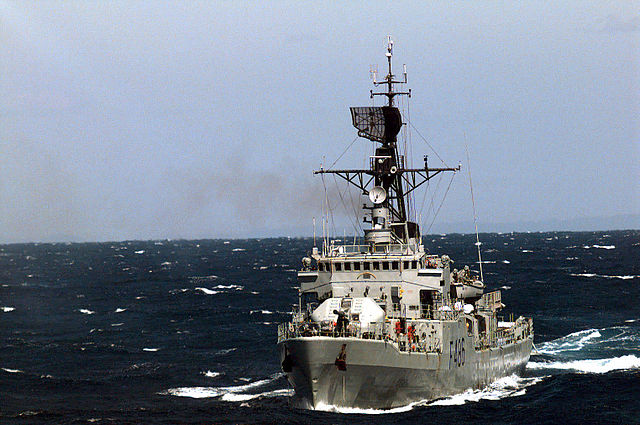
The Baptista de Andrade sub-class of the Coutinho class corvettes, were built for the Portuguese Navy by BAZAN in Spain in the 1970s. Yhey are an updated version of the João Coutinho class designed by Rogério de Oliveira and intended for overseas territories. The official record had them proposed to the South African Navy, with a delivery canceled after the Portuguese Carnation Revolution and due to be sold to the Colombian Navy in 1977 until the deal was scrapped. NRP Oliveira e Carmo was decommissioned in 1999, officially scrapped on 1 November 2007, later sunk as an artificial reef on 30 October 2012 NRP Afonso Cerqueira was decommissioned on 13 February 2015, sunk as an artificial reef off Madeira. Another was decommissioned in 2017 and the last is in limited service, pending replacement by the Viana do Castelo-class patrol vessels.

⚙ specifications |
|
| Displacement | 1,203 t standard, 1,380 t full load |
| Dimensions | 84.6 m (277 ft 7 in) x 10.3 x 3.1 m (33 ft 10 in x 10 ft 2 in) |
| Propulsion | 2 shaft, 2 OEW Pielstick diesel engines, 7,870 kW (10,560 bhp) |
| Speed | 23 knots (43 km/h; 26 mph) |
| Range | 5,900 nmi (10,900 km; 6,800 mi) at 18 knots (33 km/h; 21 mph) |
| Armament | 1× 100mm (4 in)M68, 2×1 40 mm/L70 Bofors, 2×3 324 mm TTs, 1 Super Lynx Mk95 |
| Sensors | AWS-2 S.radar, TM-626 Nav radar, Kelvin Huges KH5000 radar, pollux FCR, Diodon sonar, DECCA RM31P |
| Crew | 113 |
 Vasco da Gama class Frigates (1989)
Vasco da Gama class Frigates (1989)

ATLANTIC OCEAN (July 13, 2009) POS Corte Real (F 332) participates in a pass and review during the North Atlantic Council (NAC) at Sea Day Aboard Nimitz class aircraft carrier USS Dwight D. Eisenhower (CVN 69). The Eisenhower Carrier Strike Group is operating in the U.S. 6th Fleet area of responsibility after a regularly scheduled five month deployment in the U.S. 5th Fleet area of operations in support of Operation Enduring Freedom and Maritime Security Operations. U.S. Navy photo by Mass Communication Specialist Seaman Apprentice Shonna Cunningham
The Vasco da Gama class is a class of frigates of the Portuguese Navy. Named in honor of the Portuguese explorer Vasco da Gama, the ships are based on the German MEKO 200 design, and are Portugal’s major surface ships. Portugal operates three ships of this class, which were built in Hamburg by Blohm + Voss (B&V) and by Howaldtswerke-Deutsche Werft (HDW) in Kiel, using modular construction techniques. The project for the construction of three frigates of this class was authorized by the Portuguese Government in 1985, five years after the request of the Portuguese Navy for the acquisition of new surface ships. According to Conway’s, 60% of the funding for these ships came from NATO military aid. Similar ships have been built for the navies of Greece, Turkey, Australia and New Zealand.

⚙ specifications |
|
| Displacement | 2,920 tons standard, 3,200 tons full load |
| Dimensions | 115.9 x 14.8 x 6.2m (380 ft 3 in x 48 ft 7 in x 20 ft 4 in) |
| Propulsion | 2 shaft CODOG CP propellers, 2x MTU 20V 956 TB92 diesel 8.14 MW, 2x GE LM2500 gas turbines 38 MW |
| Speed | 32 knots (59 km/h; 37 mph) gas turbines 20 knots (37 km/h; 23 mph) Diesel |
| Range | 4,000 nmi (7,400 km; 4,600 mi) at 18 knots (33 km/h; 21 mph) |
| Armament | 100 mm Mod68, 1× CIWS, 2×3 12.75-in Mark 46 TTs, 2×4 RGM-84 Harpoon, 8 RIM-7 Sea Sparrow |
| Protection | APECS II/700 ESM, SRBOC launcher |
| Sensors | Thales DA08, MW08, 2x STIR 180 FCR, 1x SQS510 hull sonar |
| Air Group | 2 Super Lynx Mk.95 helicopters, hangar |
| Crew | 180: 19 officers, 40 NCOs, 102 enlisted, 13 air crew, 6 boarding team |
 Narval class submarines (1948)
Narval class submarines (1948)
S160 Narval, S161 Nautilo, S162 Neptuno
British former S-class mass-built WW2 submersibles. Former HMS Spur, Saga, Spearhead. Their light 20 mm AA gun and three MGs were landed in 1961. They were acquired in 1948 and discarded in 1967-69, replaced by the Daphne class.
 Albacora class submarines (1966)
Albacora class submarines (1966)
Albacora, Barracuda, Cachalote, Delfim S-163-166
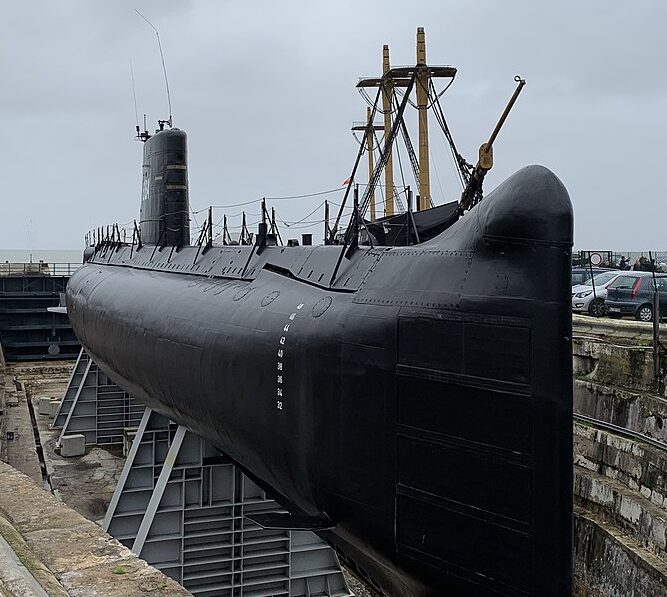
French designed Daphne class submarines, ordered to France, Dubigeon yard in 1964, laid down in 1965-67, launched 1966-68, completed in 1967-69. Slightly modified to Portuguese requirements, they were fitted to operate in tropical waters, with a complement of 50, DRUA-31 radar, DUUA-1 active sonar, DSUV passive sonar. They were discarded in the late 1990s. In 1975, Cachalote was sold to Pakistan, renamed Ghazi. These ex-British S class submarines, built in 1943-45, were all purchased in 1948. The light AA guns (J-20mm, 3-0.303in (7.7mm)) were landed in 1961. The ‘S’ class boats were replaced by the Daphnes. These French-designed Daphne type submarines were ordered in 1964 and are slightly modified to suit Portuguese requirements. They are fitted for operating in tropical waters, have a complement of fifty and DRUA-3] radar and DUUA-1 active and DSUV passive sonar. They are scheduled Cachalote was puchased by Pakistan in December 1975 and renamed Ghazi.
 Portuguese Landing Crafts
Portuguese Landing Crafts
LCT type 1945: ALFANGE (LDG 101) 1964 (To Angola 1974); ARIETE (LDG 102) 1964 (to Mozambique 1975); BACAMARTE (i) 1964 (Discarded 1976, LDG 103); CIMITARRA 1965 (To Mozambique, LDG 104) 1975; MONTANTE 1965 (Discarded 1976, LDG 105); BOMBARDA 1969 Extant 1995 (LDG 201), ALABARDA (LDG 202) 1970, Extant 1995; BACAMARTE (ii) 1985 Extant 1995 (LDG 203)
The LCT were based on the British LCT (4) Type. The last two differ slightly from the first five. They have Decca RM-316 radar. Built by Mondego S Yd. Three extant 1995.
LCM Type: LDM 101 121 1963-72 (50t): Three extant 1995.
The LCM are based on the USN LCM type. The four series differ slightly from one another; all built by Mondego S Yd. Most were discarded in 1975.
LDM Type: 201-205 1963-65 50t None extant 1995 LDM 301-313 1964-67. None extant 1995 LDM 401-424 1964-67 56t 5 extant 1995 LCM npe
76: LDM 424 was deleted in 1982 and LDM 421 in 1993, and both transferred to Guinea-Bissau in October 1993. Only LDM 119 121, 406, 418, 420, 422 and 423 extant 1995.
Other minor landing craft:
A number of 12t assault landing craft designated LD (later LDP) were built at Mondego from 1966 onwards in three series LDP 101 LDP 109, LDP 201 LDP 217, LDP 301-LDP 304. Most were discarded in 1975, leaving only LDP 216m service m 1982, which has since been deleted.
Ex-British BANGOR class corvettes:
Particulars: As British Bangor class:
F470 CACHEU Dufferin, 1950 Discarded (ex-Comandante Toronto 1971 Almeida Carvalho, ex-Fort York, ex-Mingan) 4525 ALMIRANTE N Vancouver 1946 Discarded LACERDA 1975 (ex-Caraquet).
The Bangor class fleet minesweepers Caraquet and Fort York (ex-Mingan) were buit in Canada in 1941 and served in the Canadian Navy before being sold to the Portuguese Navy on 29 June 1946 and 26 September 1950 respectively renamed Almirante Lacerda (A 525) and Comandante Almeida Carvalho (A527), Both were originally employed as survey ships, but in 1965 Carvalho was named Cacheu and reclassified as a corvette. Both ships were armed with 3-in (76mm) and 2x 20mm.
British ISLES class patrol vessels
Particulars: As British ‘Isles’ class. Four British ‘Isles’ and ‘Tree’ class minesweeping trawlers were lent to Portugal from October 1943 to July 1945, Bruray as P 1, Mangrove as P 2, Hayling as
me and Whalsay as P 4. They were later purchased by Portugal: Bruray on 11 february 1946 as Sao Miguel, Mangrove on 11 February 1946 as Faial, Hayling ‘11 June 1946 as Terceira and Whalsay on 11 June 1946 as Santa Maria, Salarelo (‘Dance’ class) was purchased by Portugal on 4 August 1946 and named Salvador Correia, and Ruskholm was purchased on 2 September 1949.
‘nd renamed Baldaque da Silva. The latter was used first as a patrol vessel, then as a minesweeper and then as a survey ship. The others were used mainly as patrol vessels, Correia being stationed in Angola. Sao Miguel was discarded in 1956, Zercetra in 1957, Correta in 1961, Fatal in 1967 and Santa Mana in 1968. When the first Correia was discarded in 1961, Da Stlvua was renamed Salvador Correta and took the preceding ship’s place in Angola. She was dis~ carded in the early 1970s. They were all armed with 1-—3in (76mm) and 2 20mm. Correia (ex-Da Silva)’s 3in (76mm) was removed in 1964.
Ex-US PC type parrol vessels
Particulars: As US PC type. Principe (P 581, ex-Flores, ex-PC 812), Madeira (P 582, ex-PC 811), Santiago (P 583, ex-PC 1257), Sal (P 584, ex-IC 809), Sao Tome (P 585, ex-PC 1256), Sao Vicente (P 586, ex-PC 1259). Six ex-USN PCs were purchased by Portugal in 1948 under MDAP. They were originally employed mainly for air-sea rescue patrols off the Portuguese, Azores and Madeira coasts. In 1957 they were rearmed to bring them up to the standards of the new Le Fouguetx type. Their 3in (76mm) and 2 20mm guns were removed and the new armament was 140mm, 3-20mm (3 x 1), 1 Hedgehog ASW mortar and 4 DCT, Sanriago was discarded in July 1967 and the remainder were discarded during 1968 69.
French LE FOUGUEUX
Type patrol vessels Particulars: As French Le Fougueux class Class (no, launched): Dubigeon Mato (P 587, ex-Funchal, 27.9.54) Normand — Porto Santo (P 588, 9.2.55), Sao Nicolau (P 589, 7.6.55) Viana do Castelo — Brava (P 590, 2.5.56), Fago (P 591, 2.5.56) Mondego — Boavista (P 592, 10.7.56) Alfeite D Yd — Santo Antao (P 593, 8.6.56), Santa Luzia (P 594, 17.1.57)
Displacement: 180t standard; 210t full load
Dimensions: 131ft 3in pp, 136ft 8in oa x 20ft 6in x 7ft 40.0m, 41.7m x 6.2m x 2.1m
Machinery: 2 shafts, 2 Maybach diesels, 1200bhp = 17kts.
Oil 16t Armament: 240mm (2 x 1)
Sensors: Radar? Complement: 24
Class: Argos (P 372), Cassiopeia (P 373), Dragao (P 374), Escorpido (P 375), Hidra (P 376), Lira (P 361), Orion (P 362), Pegaso (P 379), Centauro (P 1130), Sagitario (P 1134)
Argos class patrol Vessels
Six Argos class were built at Alfeite and four at Viana do Castelo between June 1963 and September 1965. They were intended for use in the Portuguese colonies. Centauro, Escorpiao, Lira, Orion and Pegaso were transferred to Angola in 1975, with Argos and Dragdo for spares, while Cassiopeia was discarded in 1975 and Hidra and Sagitario in 1976.
CACINE class patrol vessel
Displacement: 292t standard; 310t full load
Dimensions: 144 ft 5in x 25ft 2in x 7ft 3in 44.0m x 7.7m x 2.2m
Machinery: 2 shafts, 2 MTU diesels, 4400bhp = 20kts. Range 4400nm at 12kts
Armament: 240mm (2 x 1), 1-37mm RL (1 x 32)
Sensors: Radar KH-975
Complement: 33
Class: Cacine (P 1140), Cunene (P 1141), Mandovi (P 1142), Rovuma (P 1143), Quanza (P 1144), Geba (P 1145), Zaire (P 1146), Zambesi (P 1147), Limpopo, (P 1160), Save (P 1161)
The first four ships were built to this design at Alfeite D Yd during 1967-69. The next six were built at Mondego, during 1968 71 and Limpopo and Save in 1973. They replaced the earlier PC and Le Fougueux type patrol vessels. All were extant in 1995.
 Portuguese Coastal Boats
Portuguese Coastal Boats
Fairmile ‘B’ type:
Launched 1942-44, 85.6t full load: ALTAIR (L 1) BU 1955, DENEB (L. 4) Discarded 1959 BELATRIX (1,2) Discarded c1959; ESPIGA (L 5) Discarded Nov 1959, CANOPUS (L 3) Discarded FOMALHAUT Discarded Sep 1959 (L 6).
Albatroz class: Launched 1974-75, 45t full load. Class: ALBATROZ (Extant), AGUIA (P 1165) Extant (P 1162) 1995, ACOR (P1163) Extant, CONDOR (P 1166), Extant 1995 1995, ANDORHINA Extant, CISNE (P 1167) Extant (P 1164)
Dom Aleixo class:
Launched 1967, 67.7 tons full load: DOM ALEIXO (Extant); DOM JEREMIAS (Extant) P 1148/P 1149).
Alvor class:
Launched 1966-67, 35.7t full load. ALVOR (P 1156) Discarded 1975, ALJELUR Discarded 1975 (P 1158) 1975, ALBUFEIRA Discarded (P 1157) 1975
Jupiter class:
Launched 1944-65, 49t full load: JUPITER (P 1132), SATURNO (P 1136), MARTE (P 1134): To Angola, URANO (P 1137) 1975, MERCURIO (P 1135), VENUS (P 1133) To Angola 1975
Belatrix class:
Launched 1961-62, 29t full load. ALDEBARAN, FOMALHAUT (Survey ship 1975/P 367), ALTAIR (P 377), To Angola. POLLUX (P 368), To Angola 1975. ARCTURUS (Discarded) PROCION Discarded 1975 as P 1153); BELATRIX (Discarded=, RIGEL (P 378): To Angola (P 363) 1975; CANOPUS (Discarded), SIRIUS: To Mozambique as P 364 in 1975. DENEB (P 365), Discarded. VEGA To Mozambique 1975. ESPIGA (P 366) To Angola 1975. Built by Beyerische Schiffbau, Germany.
Algol class:
Launched 1964, 24t full load. ALGOL (P 1138) Discarded. Armed with 120 mm mortar. Algol was built by Argibay, Lisbon, and armed with 2 MG. Castor was built by Mondego and armed with 1-20mm.
Castor class:
Launched 1964, 22t full load. CASTOR (P 580) Discarded 1976
Antares class:
Launched 1959, 18t full load: ANTARES (P 360), Mozambique; SIRIUS Sunk Dec 1961. VEGA Sunk; REGULUS (P 369) Dec 1961
Rio Minho class:
Launched 1957, 14t full load. Fairmile ‘B’ type motor launches were purchased from Britain in 1946, They were disarmed and used as air-sea rescue launches. A large deckhouse was built aft.
RIO MINHO Extant 1995 (P 370)
Albatroz class: Six built at Alfeite 1974-75, eight more built since. RM-316P radar, armed with a 20mm AA and 2x 0.5in (12.7mm) HMG. Dom Jeremias is in use as a survey craft.
All built at Alfeite, and were armed with either 1-20mm or 2 MG, see one armed with 1-20mm.
Built by Mondego. Two were transferred to Angola; of the remainder, three went to Mozambique and one was discarded, but it is not clear which one.
Antares class:
Designed by James ‘Taylor, Shorcham, who built Antares and the glass fiber hulls of the other three, Sirtus and Vega were sunk in action with India at Goa against combined forces during the invasion and annexation of Goa in 1961. Rio Minho patrolled the River Minho on the Spanish-Portuguese border.
 Portuguese Minesweepers
Portuguese Minesweepers
US AGILE type ocean minesweepers:
Particulars: As US Agile class. USN Agile type MSOs built in the USA for Portugal under MDAP. While building they were assigned the USN designations MSO 487, 486, 479 and 478 respectively. They were all laid down in 1953 and commissioned between 24 April 1955 and 23 November 1955.
Class: M418 CORVO (Burger Boats 28.7.54) Discarded 1973, M417 GRACIOSA (Burger Boats 19.11.53) Discarded 1973, M416 PICO (Bellingham 18.6.54) Discarded 1973, M415 SAOJORGE (Bellingham 30.4.54) Discarded 1973.
British “TON” type coastal minesweepers:
Particulars: As British “Ton’ class.
Four ‘Ton’ class coastal minesweepers were built in the CUF Shipyard, 1954-57. Lagoa and Sao Rogue were funded by the USA under MDAP, and Ribeira Grande and Rosairo were paid for by Portugal. They had been ordered in 1954. Their 140mm gun was removed in 1972, leaving them with 220mm. All were extant in 1995, but are now used as patrol vessels.
Class: Sao Roque (M 401), Ribeira Grande (M 402), Lagoa (M 403), Rosario (M.404).
Ex-US ADJUTANT class:
Coastal minesweepers Particulars: As US Adjutant class. Eight USN Redwing type MSC were built in the USA 1951-53 and transferred under MDAP to Portugal 1953 55. Ponta Delgarda (ex-Adjutant, AMS 60), Santa Cruz (ex-AMS 92) and Angra do Heroismo (ex-AMS 62) were discarded in 1973, Santa Cruz (ex-AMS 92) and Lajes (ex-AMS 146) were discarded in 1975 and J/Jorta (ex-AMS 61), Vila do Porto (ex-AMS 91) and Velas (ex-AMS 145) were discarded in 1976.
Class: Ponta Delgada (M 405), Horta (M 406), Angra do Heroismo (M 407), Vila do Porto (M 408), Santa Cruz (M 409), Velas (M 410), Lajes (M 411), Sao Pedro (M 412)
Read More/Src
Links
helion.co.uk portuguese-colonial-war
arquivo.pt/ areamilitar.net/
web.archive.org/ marinha.pt/ nrpbarracuda.aspx
navypedia.org comandante_joao_belo.htm
navypedia.org/ diogo_cao.htm

 Latest Facebook Entry -
Latest Facebook Entry -  X(Tweeter) Naval Encyclopedia's deck archive
X(Tweeter) Naval Encyclopedia's deck archive Instagram (@navalencyc)
Instagram (@navalencyc)





 French Navy
French Navy Royal Navy
Royal Navy Russian Navy
Russian Navy Armada Espanola
Armada Espanola Austrian Navy
Austrian Navy K.u.K. Kriegsmarine
K.u.K. Kriegsmarine Dansk Marine
Dansk Marine Nautiko Hellenon
Nautiko Hellenon Koninklije Marine 1870
Koninklije Marine 1870 Marinha do Brasil
Marinha do Brasil Osmanlı Donanması
Osmanlı Donanması Marina Do Peru
Marina Do Peru Marinha do Portugal
Marinha do Portugal Regia Marina 1870
Regia Marina 1870 Nihhon Kaigun 1870
Nihhon Kaigun 1870 Preußische Marine 1870
Preußische Marine 1870 Russkiy Flot 1870
Russkiy Flot 1870 Svenska marinen
Svenska marinen Søværnet
Søværnet Union Navy
Union Navy Confederate Navy
Confederate Navy Armada de Argentina
Armada de Argentina Imperial Chinese Navy
Imperial Chinese Navy Marinha do Portugal
Marinha do Portugal Mexico
Mexico Kaiserliche Marine
Kaiserliche Marine 1898 US Navy
1898 US Navy Sovietskiy Flot
Sovietskiy Flot Royal Canadian Navy
Royal Canadian Navy Royal Australian Navy
Royal Australian Navy RNZN Fleet
RNZN Fleet Chinese Navy 1937
Chinese Navy 1937 Kriegsmarine
Kriegsmarine Chilean Navy
Chilean Navy Danish Navy
Danish Navy Finnish Navy
Finnish Navy Hellenic Navy
Hellenic Navy Polish Navy
Polish Navy Romanian Navy
Romanian Navy Turkish Navy
Turkish Navy Royal Yugoslav Navy
Royal Yugoslav Navy Royal Thai Navy
Royal Thai Navy Minor Navies
Minor Navies Albania
Albania Austria
Austria Belgium
Belgium Columbia
Columbia Costa Rica
Costa Rica Cuba
Cuba Czechoslovakia
Czechoslovakia Dominican Republic
Dominican Republic Haiti
Haiti Hungary
Hungary Honduras
Honduras Estonia
Estonia Iceland
Iceland Eire
Eire Equador
Equador Iran
Iran Iraq
Iraq Latvia
Latvia Liberia
Liberia Lithuania
Lithuania Mandchukuo
Mandchukuo Morocco
Morocco Nicaragua
Nicaragua Persia
Persia San Salvador
San Salvador Sarawak
Sarawak Uruguay
Uruguay Venezuela
Venezuela Zanzibar
Zanzibar Warsaw Pact Navies
Warsaw Pact Navies Bulgaria
Bulgaria Hungary
Hungary

 Bundesmarine
Bundesmarine Dutch Navy
Dutch Navy Hellenic Navy
Hellenic Navy Marina Militare
Marina Militare Yugoslav Navy
Yugoslav Navy Chinese Navy
Chinese Navy Indian Navy
Indian Navy Indonesian Navy
Indonesian Navy JMSDF
JMSDF North Korean Navy
North Korean Navy Pakistani Navy
Pakistani Navy Philippines Navy
Philippines Navy ROKN
ROKN Rep. of Singapore Navy
Rep. of Singapore Navy Taiwanese Navy
Taiwanese Navy IDF Navy
IDF Navy Saudi Navy
Saudi Navy Royal New Zealand Navy
Royal New Zealand Navy Egyptian Navy
Egyptian Navy South African Navy
South African Navy






























 Ukrainian Navy
Ukrainian Navy dbodesign
dbodesign